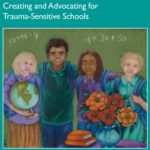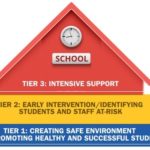INformation Hub
Building Trauma-Informed Schools
Building Trauma-Informed Schools
A resource collection compiled by and for Parent Centers.
Coordinated by the Region 2 Parent Technical Assistance Center @ ECAC
September 2018
 What does it mean to be a trauma-informed school? This part of the collection identifies resources that answer that question; includes information for educators about creating a trauma-informed classroom for their students; shares tools and training resources for schools to use in professional development; and ends with a sampling of self-assessmentinstruments for organizations, especially schools.
What does it mean to be a trauma-informed school? This part of the collection identifies resources that answer that question; includes information for educators about creating a trauma-informed classroom for their students; shares tools and training resources for schools to use in professional development; and ends with a sampling of self-assessmentinstruments for organizations, especially schools.
- What Does It Mean to Be a Trauma-Informed School?
- In the Classroom: Info for Educators
- Tools and Training for Professional Development in School Systems
- Self-Assessment and Other Resources
This web page of resources is one part of the larger Resource Collection on Trauma-Informed Care, a mini-library put together through a collaboration of RPTAC 2 @ ECAC, CPIR, and a review and development team of Parent Center staff.
What Does It Mean to Be a Trauma-Informed School?
What Is a Trauma-Informed School?
In a trauma-informed school, the adults in the school community are prepared to recognize and respond to those who have been impacted by traumatic stress. In addition, students are provided with clear expectations and communication strategies to guide them through stressful situations. This web article briefly describes the components of being a trauma-informed schools and then provides multiple paths to learn more. From the Treatment and Services Adaptation Center, a program of SAMHSA.
https://traumaawareschools.org/traumainschools
![]() Trauma Sensitive Schools | Video
Trauma Sensitive Schools | Video
Parent Centers will find this 10-minute video very useful for sharing with staff, families, and educators. The video is part of a 3-video series for which Formed Families Forward has created many additional handouts and factsheets. Find all at Formed Families Forward, which is the CPRC serving foster, adoptive, and kinship families in Arlington, Fairfax, Loudoun, and Prince William counties in Virginia, as well as in the city of Alexandria.
https://www.formedfamiliesforward.org/resource_category/trauma/
Frequently Asked Questions about Trauma-Sensitive Schools
A trauma-sensitive school is one in which all students feel safe, welcomed, and supported and where addressing trauma’s impact on learning on a school-wide basis is at the center of its educational mission. This FAQ is brief (only 6 questions and concise answers), but each answer connects to additional information, such as a description of the attributes of a trauma-sensitive school. From the Trauma and Learning Policy Initiative.
https://traumasensitiveschools.org/frequently-asked-questions/
![]() Video | Why We Need Trauma-Sensitive Schools
Video | Why We Need Trauma-Sensitive Schools
This 11-minute video comes from the Trauma and Learning Policy Initiative and is accompanied by a video discussion guide designed for educators and others who want to embark on or engage in the process of creating trauma-sensitive schools.
https://traumasensitiveschools.org/why/
Trauma-Informed Schools: Introduction to the Special Issue
In School Mental Health, March 2016, Volume 8, Issue 1, pp 1–6.
This is the introduction to a special issue of the journal that focuses on trauma-informed schools. It’s useful for those who would like to read a good literature review and find out the key assumptions of trauma-informed approaches and the forces behind the movement.
https://link.springer.com/content/pdf/10.1007%2Fs12310-016-9184-1.pdf
Unlocking the Door to Learning: Trauma-Informed Classrooms & Transformational Schools
24-page brief from the Education Law Center This issue brief discusses how educators can begin to understand the role of trauma, its effect on children and learning, and how educators can change methods of interacting and responding to children impacted by trauma. It reviews:
This issue brief discusses how educators can begin to understand the role of trauma, its effect on children and learning, and how educators can change methods of interacting and responding to children impacted by trauma. It reviews:
- evidence-based approaches at the organizational level that can break the cycle;
- the 7 key elements of trauma-informed systems; and
- what being trauma-informed in the classroom looks like.
The brief concludes with recommendations for state, for administrators and educators, and for revising school discipline policies, as well as a short of list of other resources. https://www.elc-pa.org/wp-content/uploads/2015/06/Trauma-Informed-in-Schools-Classrooms-FINAL-December2014-2.pdf
In the Classroom: Information for Educators
What Survival Looks Like in School
Inner World Work (UK) | Here’s a collection of different materials for different audiences, all adapted from the same basic 28-page guide intended for educators and families to understand the fight-freeze-flight response that traumatic events can cause in children. Told from the child’s perspective. Among the offerings are:
- What Survival Looks like in Primary School (28 pages)
- Quick Reference Guide (1 page, infographic of the fight-freeze-flight of trauma)
- What Survival Looks Like in Secondary School
- What Survival Looks Like for Me (Workbook that children can fill out to capture how they feel and what they do when fighting, freezing, or fleeing)
Access all of these resources at: http://www.innerworldwork.co.uk/?page_id=45
![]() Video | Tips for Teachers
Video | Tips for Teachers
From the Coalition for Children, Youth and Families
This 13-minute video explains how teachers can adapt some typical class assignments to include any children they have who may be in out-of-home care or who have been adopted.
https://vimeo.com/111772432
 Child Trauma Toolkit for Educators
Child Trauma Toolkit for Educators
21-page document from the National Child Traumatic Stress Network
The toolkit is easy to read and nicely presented, with sections on: (a) trauma facts for educators, suggestions, and the impact of trauma (separately discussed for preschoolers, elementary school students, middle school, and high school students); (b) childhood traumatic grief; and (c) self-care for educators. The toolkit ends with a guide for parents as to understanding child traumatic stress.
https://wmich.edu/sites/default/files/attachments/u57/2013/child-trauma-toolkit.pdf
10 Things About Childhood Trauma Every Teacher Needs to Know
Learning can be a big struggle for children who have experienced trauma. This article spotlights 10 important things for teachers to know about how trauma affects children and learning. It is the first article in a series sponsored by the National Institute for Trauma and Loss in Children (TLC). See also the full blog series, which shares expert answers to teachers’ toughest questions. This includes tips for understanding kids who have been through trauma and strategies for helping them.
https://www.weareteachers.com/10-things-about-childhood-trauma-every-teacher-needs-to-know/
With Student Trauma, It’s OK to Set Boundaries
Student trauma impacts teachers, too. Taking care of yourself isn’t a luxury—it’s a necessity.
https://www.edutopia.org/article/student-trauma-its-ok-set-boundaries
Tools and Training for]Professional Development in School Systems
Trauma Aware Schools
This website is a vehicle for promoting trauma-informed school systems. It includes guidance on:
- Psychological First Aid—Listen, Protect, Connect, a five-step crisis response strategy;
- CBITS, an evidence-based intervention for traumatized students;
- Support for Students Exposed to Trauma (SSET), an evidence-based intervention for school staff to help students exposed to traumatic events;
- the Trauma Responsive Schools Implementation Assessment (TRS-IA), a quality improvement tool designed to support schools and districts working to enhance their trauma responsive programming.
Access a wealth of this and other information, at:
https://traumaawareschools.org/traumainschools
Trauma Sensitive Schools | Website
From the Trauma and Learning Policy Initiative (TLPI) of Massachusetts Advocates for Children and Harvard Law
This website is an excellent resource for school systems and states to consult. Its purposes are to:
- help schools create trauma-sensitive environments;
- improve trauma-sensitive approaches to meeting the needs of individual children at school in both regular and special education;
- engage in a public education campaign to teach policymakers, educators, administrators, health and mental health providers, and parents about the impact of trauma on learning and the need for trauma-sensitive schools.
Access the multitude of resources at: https://traumasensitiveschools.org/
 A Guide to Creating Trauma-Sensitive Schools: Creating and Advocating for Trauma-Sensitive Schools
A Guide to Creating Trauma-Sensitive Schools: Creating and Advocating for Trauma-Sensitive Schools
You can download a free copy of this 140-page guide merely by entering your name, affiliation, and email address. It is long, yes, but it’s thorough and, often, step-by-step. Well-suited for administrators and school district leaders.
https://tinyurl.com/y87hoja6/
![]() Implementing Trauma-Informed Care in Schools | Video
Implementing Trauma-Informed Care in Schools | Video
From the Trauma Informed Care Project.
In this 4-minute video, a first-grade teacher talks about creating a “safe zone” in her classroom to help students when they are angry or frustrated. It is a place they can go to without asking for permission.
https://www.youtube.com/watch?v=3dkD940XQx4#t=193
Creating, Supporting, and Sustaining Trauma-Informed Schools: A System Framework
13-page brief from the National Child Traumatic Stress Network 
The NCTSN System Framework for Trauma-Informed Schools will help schools and sites who partner with schools have a better sense of the areas to address when working towards a more trauma-informed school. The framework is rooted in the Multi-Tiered Systems of Support (MTSS) approach for the early identification and support of students with learning and emotional/behavior needs. The framework infuses all three tiers of the MTSS with trauma-informed concepts and practices, and also recognizes and addresses the broader contexts in which these tiers operate: school environment/culture, community, and family partnerships.
Trauma | Learning Modules for Professional Development
From the Midwest PBIS Network.
Well suited to the professional development needs of school systems, this set of learning modules provides schools with 8 modules and extensive additional materials (handouts, self-assessments, videos). Modules focus on: self-care for educators; the basics of trauma; trauma and the brain; the fight-flight-freeze response; trauma-informed classroom practices; integrating trauma into the current system; professional development plans; and coaching skills.
http://www.midwestpbis.org/materials/special-topics/trauma
Trauma-Sensitive Schools | Learning Modules for Online Professional Development
From the Wisconsin Department of Public Instruction.
Also extremely well suited to the professional development needs of school systems, here is a great set of online learning modules about trauma and trauma-sensitive schools. There are 17 modules focusing on the foundational and universal (Tier 1) practices involved in building staff and school capacity in trauma-informed care. More modules are anticipated relating to professional development and implementation of Tiers 2 and 3 (providing supports for students who need additional and/or ongoing support).
https://dpi.wi.gov/sspw/mental-health/trauma/modules
Self-Assessment Resources
While there are many tools that schools and other organizations can use to assess their own capacities or readiness as a trauma-informed system, for brevity’s sake, we’ve listed only two below, to get you started.
____________
Trauma-Informed Care Organizational Assessment
From the the Traumatic Stress Institute.
This is a tool for organizations to assess their implementation of trauma-informed care in many different domains. It comes with a guide to the assessment‘s use.
https://traumaticstressinstitute.org/resources/trauma-informed-care-organizational-assessment/
Organizational Self-Assessment: Adoption of Trauma-Informed Care Practice
From the National Council for Behavioral Health
The Organizational Self-Assessment instrument consists of 6 trauma-informed care domains, along with a set of performance standards for each. These domains and standards reflect a compilation of commonly recognized aspects of a trauma-informed care organization. A 7th domain was added to assist an organization in assessing its readiness to measure and evaluate performance improvement.
https://www.nationalcouncildocs.net/wp-content/uploads/2014/01/OSA-FINAL_2.pdf
Which part of this Resource Collection would you like to visit now?
Return to the Resource Collection landing page
Resource Collection | Basic Information about Trauma
Resource Collection | What is Trauma-Informed Care?
Resource Collection | Trauma and Specific Populations
Resource Collection | Building Trauma-Informed Schools (You’re already here)
Resource Collection | Responding to Disasters
SOURCE ARTICLE: Center for Parent Information and Resources
Give us a call at (727) 523-1130 or (800) 825-5736 or request a callback by clicking below.
311 South Missouri Ave, Clearwater, FL 33756
(727) 523-1130
(800) 825-5736

